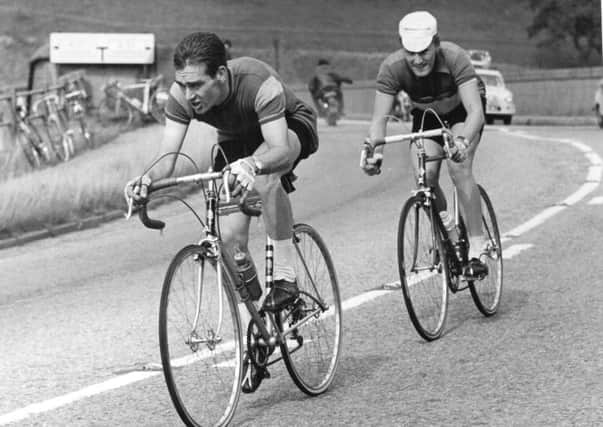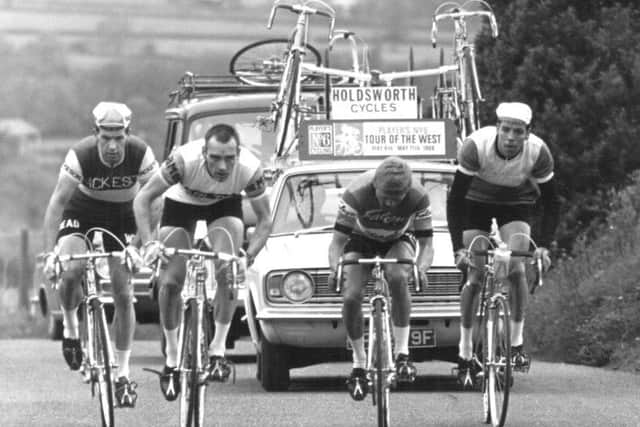Tough at the top: Tour de France legend Arthur Metcalfe


Most weekday evenings, a group of cyclists meets up at Lawnswood in north Leeds to go for a training ride. They are known as The Chaingang: an informal but legendary institution, which has played a key role in the development of numerous champions in Yorkshire cyclesport. It has been meeting like this for nearly 70 years and one of its members has played an unique role in British cycling.
Born in Leeds, Arthur Metcalfe spent part of his youth on Teesside, returning to the city after his national service in 1961. He joined the Chaingang and pedalled up to 60 miles most nights of the week, part of a 400-mile a week riding regime. “I always had to work hard to gain my form” he said. “The Chaingang was the ideal place to find it. It meant an awful lot when I eventually came onto that form, through hard graft over thousands of miles.”
Advertisement
Hide AdAdvertisement
Hide AdSid Barras from Keighley, himself a star of cycling – 18 years a professional with almost 200 victories to his credit, recalls Arthur’s dedication. “He rode with us in the Chaingang year-round, in all weathers. Yet I never ever saw him wearing gloves, hat or over-shoes… he was just following his own maxim: that training should be at least as hard as any race. And he made it extra hard for everyone when he came out. His sheer grit and determination were scary to behold, the lads used to dread him turning up.”


So a legend was born… of an uncompromising hard-man. Not surprising really, when the Metcalfe family history is reviewed. Parish records in Wensleydale and Swaledale include many of that name, who have battled the elements to make a living in those wild and beautiful places for centuries. And they were warriors. For among the Dales archers, the artillery of medieval warfare on the battlefields of Crecy and Azincourt, were numerous Metcalfes.
Arthur Metcalfe chose a bicycle rather than a long-bow to make his point. But make it he certainly did, when he returned to Leeds and teamed up with Jack Macklam and Richard Simpson in the St. Christopher’s cycling club, which was sponsored by local cycle manufacturer Bob Jackson.
He was at his best in long, hard stage races like the Tour of Britain, then known as the Milk Race. Once winner and twice runner-up in the King of the Mountains competition, Arthur took overall victory in the 1,350-mile race in 1964. He then went on to confirm his reputation over the next eight years, making a mark on British cycling which remains unequalled to this day.
Advertisement
Hide AdAdvertisement
Hide AdIn 1965 Arthur was selected for the British team to ride in the Isle of Man International, a race over three laps (113 miles) on the Manx TT circuit. The day before the race he set out from his home in Leeds to cycle to Liverpool to catch the ferry to the island. Carrying his racing wheels on attachments to his front forks, his saddlebag containing his racing kit, he arrived at the pier only to learn that the evening ferry had been cancelled.
After spending the night standing dozing in a phone box, Arthur caught the morning ferry. He changed on the boat and readied his bike, cycled off the gangway and up to the race start. Then set off in a large field made up of many of the best amateur racers in Europe… and proceeded to beat them all. “A crushing victory,” the Daily Telegraph described it. This Manx episode was the stuff of legend and so the Metcalfe image was created: of a tough, hard, relentless and clever fighter, overcoming all the odds to gain success in the manner of his Yorkshire origins.
The following year, after winning the 110-mile National Road-Race Championship Arthur said he was feeling “a bit stale”. So he switched his attentions to time-trialling, the traditional individual race against the watch which had been the cornerstone of British cyclesport for 70 years. During September 1966 he rode the three events required to qualify for the title of British Best All-Rounder: 50 miles, which he completed at 26.5mph; 100 miles (at 25mph). And the 12-hour marathon, in which he covered 270 miles.
In the process he convincingly won the BBAR competition, then the holy grail of thousands of riders around the country.
Advertisement
Hide AdAdvertisement
Hide AdCombined with his roadrace title, it was an unique double – which remains unmatched to this day. And Arthur’s victory, at a record average speed of 24.8mph, finally brought to a close an era which had lasted many decades, during which British cycling had been a sport split into factions.
Racers had participated almost exclusively in either road-racing or time-trialling, refusing to speak to each other and at times even coming to blows over their differing sporting viewpoints.
In winning the Best All-Rounder Metcalfe gave full meaning to the title. The sport’s magazine Cycling Weekly described his performances as “magnificent” and praised Arthur for bridging the gap, for once and for all, between British cycling’s two solitudes.
In 1967 Arthur Metcalfe sought a new challenge. He became part of a fledgling UK professional class and rode in the 3,000-mile Tour de France in a composite British team. It was a tough baptism of fire, made even worse by the fact that the race organisers lost his suitcase and Arthur had to ride the first 600 miles in borrowed shoes and shorts.
Advertisement
Hide AdAdvertisement
Hide AdThen disaster struck. The British team leader Tom Simpson collapsed on his bike and died while climbing the steep, barren slopes of Mont Ventoux on the thirteenth day of the race, on July 13. It was a dreadful event, which sent a shock-wave through the entire sports world, associated as it was with drug use. Arthur nevertheless decided to continue, riding the remaining 1,400 miles of the race to Paris to honour the memory, as he put it, of his lost leader.
But he was probably never quite the same rider again after that soul-searing experience, which had affected him deeply.
Nevertheless, the following year Arthur rode the Tour de France again and his lone attack on the 125-mile stage to Bayonne was noted in the media: “un bel exemple du courage” reported the sports newspaper L’Equipe which also referred – respectfully, to les coureurs Britanniques en vacance: a reference to the fact that while professional, some of the British riders, like Arthur, still had a job at home and took their annual holiday to ride in the Tour de France.
Arthur continued to race in the UK as a professional. In 1971 he broke his pelvis in a crash. He recovered his form riding with the Chaingang and in 1973 was invited to ride the Rapport Tour of South Africa and to coach young African riders. “Grand Old Man Metcalfe Rides In” reported the S.A. Sunday Times of his win in the 1,100-mile international race.
Advertisement
Hide AdAdvertisement
Hide AdBut he had fallen foul of the politics of the sport, which were alien to his nature.
As a result of his visit, Arthur was suspended sine die by the British cycling authorities, who had never particularly liked his determined, direct northern way of doing things. “You do your best and you get to the top, then they can’t wait to topple you,” he said in an interview shortly before he died. “If they had seen what I achieved with those lads in Africa they would have rewarded me with a medal, not the ultimate insult of a lifetime suspension.”
When he was forced to retire from racing, Arthur Metcalfe moved to Harrogate, where he became a partner in a bespoke cycle frame-building business. He was not a bitter man. He enjoyed cycling in his spiritual home of the Yorkshire Dales until he was diagnosed with cancer. “I realised something was wrong” he said bluntly, “when I couldn’t go as fast as I used to.” He died in 2002.
Arthur Metcalfe’s cycling career was best summarised by the doyen of British cycling journalists of the time, Alan Gayfer: “By his dignity, exceptional ability, stubborn determination and speed … and his way of approaching cycling in Britain as a whole instead of thinking of it as divided, Arthur united the two hitherto-incompatible sides of our sport. He should never be forgotten.”
Advertisement
Hide AdAdvertisement
Hide AdArthur’s funeral service, packed with old friends and rivals, took place not far from where the Leeds Chaingang, breeding-ground of hard men, still meets most week-nights. Tribute, in itself, to an indomitable Yorkshire sportsman.